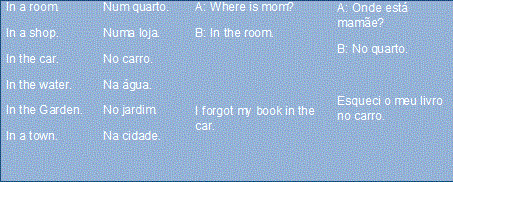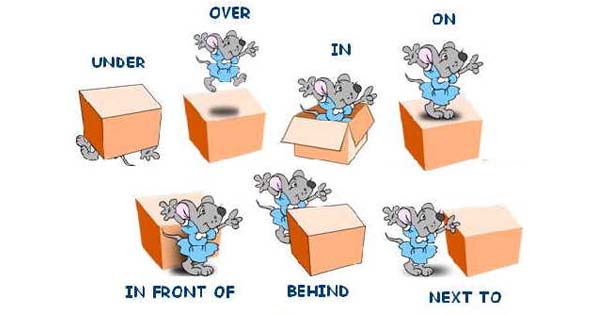Dúvidas com preposições de lugar? Não sabe a diferença entre AT, IN e ON? Leia este post e aprenda a diferença para nunca mais errar! Revise Inglês para o Enem! E no final, tem Simulado Enem Online com apenas 10 questões para você testar o que aprendeu!
Inglês Enem: Um dos pontos mais difíceis da gramática da língua inglesa é o estudo das preposições. Vários estudantes “se enrolam”, até mesmo aqueles bem fluentes, quando o assunto é a tão temerosa preposição. Afinal, quando usar at, in e on? Saiba tudo sobre as preposições de lugar com este super post de Inglês e arrase nas questões dos vestibulares e do Enem! Vem com a gente!
Vamos ver as regras básicas sobre AT/IN/ON.
Preposição é a palavra que estabelece uma relação entre dois ou mais termos da oração. Por isso elas são muito importantes na construção de um enunciado, oração e texto. Entre os elementos ligados pela preposição não há sentido separado, individualizado.
As preposições de lugar mais importantes em inglês são IN, ON, AT.
IN é uma preposição de lugar, que significa em. In é usada para espaços onde alguém ou algo está contido.


Veja os exemplos:

A preposição in também é usada antes de ruas, cidades, distritos, regiões e países. Veja:

AT também significa em. Então, você deve se perguntar? Se in significa em e at também, qual a diferença entre os dois? A diferença está no uso. AT é usada antes de endereços específicos, antes de lugares onde ocorre um serviço ou antes de um ponto de referência:
At the bus stop. – No ponto de ônibus.
At the traffic lights. – No sinal.
At the door. – Na porta.
At the airport. – No aeroporto.
At home. – Em casa.
At school. – Na escola.
At university. – Na universidade.
At a party. – Na festa.
ON também é uma preposição de lugar. Ela indica contato (sobre, em cima, acima de). Veja os exemplos:
- On a shelf.
The box is on the shelf. (A caixa está na prateleira)
- On a plate. (no prato)
There is some food on the plate. (Tem um pouco de comida no prato).
- On a balcony. (na sacada)
The chairs are on the balcony. (As cadeiras estão na sacada).
- On a wall (na parede)
- On a door. (na porta)
- On a bycicle. (na bicicleta)
- On a motorbike. (na moto)
- On a bus. (no ônibus)
- On a train. (no trem)
- On a plane. (no avião)
- On the first floor. (no primeiro andar)

Outras preposições de lugar:
Além de at, in e on, há também outras preposições de lugar que você precisa aprender para se dar bem em inglês:
- next – A is next B. – A está do lado de B.
- beside – A is beside B. – A está do lado de B.
- in front of – D is in front of B – D está na frente de B.
- behind – E is behind B. – E está atrás de B.

Between = entre
By = next to = beside = do lado
Under = embaixo de
Above = acima
Below = abaixo

I live between a bakery shop and a drugstore. (Eu moro entre uma padaria e uma farmácia).Veja como aplicar estes exemplos nas frases:
The cat is under the table. ( O gato está embaixo da mesa)
The shelves are above the table. (As prateleiras estão acima da mesa)
The table is below the pictures. ( a mesa está embaixo dos quadros).
Quer saber mais sobre preposições de lugar da língua inglesa? Então assista a videoaula do Curso Enem Gratuito:
Agora que você já sabe tudo obre as preposições de lugar, que tal testar seus conhecimentos?
QUESTÃO 1 (JFS 2000)
The cat jumped __________ the table in order __________
get the food that was __________ it.
a) up – to – on
b) about – for – up
c) over – for – about
d) on – to – on
e) onto – to – on
QUESTÃO 2 (EEAR 2007)
Choose the best alternative to complete the blanks:
Julie was born __________ July 3, __________ night
__________ New York.
a) in / at / at
b) on / at / in
c) in / at / in
d) on / in / at
QUESTÃO 3 (EFOMM 2006)
Choose the only option with the correct preposition:
The man jumped __________ the horse and went away.
a) of
b) under
c) out of
d) into
e) onto
QUESTÃO 4 (UNESP 1986)
Assinale a alternativa correta:
Fried potatoes are called “French Fries” __________ the United States.
a) on
b) about
c) of
d) from
e) in
QUESTÃO 5 (UNESP 1993)
He walked __________ the room.
a) at
b) on
c) between
d) into
e) among
GABARITO
QUESTÃO 1 – E
QUESTÃO 2- B
QUESTÃO 3 – E
QUESTÃO 4 – E
QUESTÃO 5 – D
Prepositions
Sumário do Quiz
0 de 10 questões completadas
Perguntas:
- 1
- 2
- 3
- 4
- 5
- 6
- 7
- 8
- 9
- 10
Information
.
Você já fez este questionário anteriormente. Portanto, não pode fazê-lo novamente.
Quiz is loading...
You must sign in or sign up to start the quiz.
Para iniciar este questionário, você precisa terminar, antes, este questionário:
Resultados
0 de 10 perguntas respondidas corretamente
Seu tempo:
Acabou o tempo
Você conseguiu 0 de 0 pontos possíveis (0)
| Pontuação média |
|
| Sua pontuação |
|
Categorias
- Sem categoria 0%
- 1
- 2
- 3
- 4
- 5
- 6
- 7
- 8
- 9
- 10
- Respondido
- Revisão
-
Pergunta 1 de 10
1. Pergunta
(UFPE) Some 63,000 of the boat people have wound up ____________ the British crown colony of Hong Kong, …
Correto
Parabéns! Siga para a próxima questão.
-
Pergunta 2 de 10
2. Pergunta
(UNICAP)
“What time does Mary get up on Sundays?”
“She usually gets up ………… ten o’clock.”Assinale as afirmativas verdadeiras e as afirmativas falsas.
Correto
Parabéns! Siga para a próxima questão.
-
Pergunta 3 de 10
3. Pergunta
(FESP) – Choose the correct answer:
Jim is looking forward _______________ seeing his girlfriend.
Correto
Parabéns! Siga para a próxima questão.
-
Pergunta 4 de 10
4. Pergunta
(UFPE) Thirty years __________ John Kennedy’s assassination, many people still cannot believe what happened.
Assinale as afirmativas verdadeiras e as afirmativas falsas:
Correto
Parabéns! Siga para a próxima questão.
-
Pergunta 5 de 10
5. Pergunta
(UFPE)
NewsweekT H I S W E E KThe JFK Cover-Up: Intrigues and Errors
Thirty years after John Kennedy’s assassination, many people still cannot believe what happened. A special investigation helps explain why. After the shooting, top officials scrambled to conceal __________ own intrigues and mistakes, leaving openings for dark conjecture – and a nation forever uneasy.Special Report: Page 30 – Nov.22, 1993 1
Assinale as afirmativas verdadeiras e as afirmativas falsas:Correto
Parabéns! Siga para a próxima questão.
-
Pergunta 6 de 10
6. Pergunta
(FESP)
The children have been ill ……………………….. two months.
They haven’t had a good breakfast ………………………. weeks.
In fact, they haven’t had a good breakfast ……………………………. last October.Correto
Parabéns! Siga para a próxima questão.
-
Pergunta 7 de 10
7. Pergunta
(FESP) You can learn some English ____________ listening ___________ music. Choose the correct answer:
Correto
Parabéns! Siga para a próxima questão.
-
Pergunta 8 de 10
8. Pergunta
(UNICAP) The boys and girls are playing ______ the garden. Assinale as afirmativas verdadeiras e as falsas.
Correto
Parabéns! Siga para a próxima questão.
-
Pergunta 9 de 10
9. Pergunta
(PUC-PR) Which is the right preposition to complete the propositions:
I – You’ll get to the village more quickly if you take this passage ______ the fields.
II – If you want the bus station, go ______ this road and turn left.
III – The ball passed _____ the window and broke the new vase of Antonio’s mother.
IV – Cassiane travels _____ the world mainly for pleasure.
V – Santos Andrade Square is ______ Federal University of Paraná and Guaira Theatre.
Correto
Parabéns! Siga para a próxima questão.
-
Pergunta 10 de 10
10. Pergunta
(PUC-PR) Choose the correct alternative to fill in the blanks:
I – What are you thinking ________?
II – He died ________ the injuries caused by a terrible accident.
III – They succeeded ________ breaking the door open.
IV – Everybody laughed ________ him when he said that.
V – Why don’t you concentrate ________ your studies?
Correto
Parabéns! Siga para a próxima questão.


